Pre-Packaged Food Market
Pre-Packaged Food Market Size and Share Forecast Outlook 2025 to 2035
Pre-packaged food market is projected to grow from USD 2,100.0 billion in 2025 to USD 2,877.5 billion by 2035, at a CAGR of 3.2%. Dairy & Bakery will dominate with a 38.0% market share, while modern retail will lead the distribution channel segment with a 49.0% share.
Pre-Packaged Food Market Forecast and Outlook 2025 to 2035
The global pre-packaged food market is valued at USD 2,100 billion in 2025. It is slated to reach USD 2,877.5 billion by 2035, recording an absolute increase of USD 800.0 billion over the forecast period. This translates into a total growth of 38.1%, with the market forecast to expand at a compound annual growth rate (CAGR) of 3.2% between 2025 and 2035.
The overall market size is expected to grow by nearly 1.38X during the same period, supported by increasing consumer preference for convenience foods, growing urbanization trends, rising disposable incomes, and expanding retail infrastructure across emerging markets.
Quick Stats for Pre-Packaged Food Market
- Pre-Packaged Food Market Value (2025): USD 2,100 billion
- Pre-Packaged Food Market Forecast Value (2035): USD 2,877.5 billion
- Pre-Packaged Food Market Forecast CAGR: 3.2%
- Leading Product Type in Pre-Packaged Food Market: Dairy & Bakery
- Key Growth Regions in Pre-Packaged Food Market: North America, Europe, and Asia-Pacific
- Key Players in Pre-Packaged Food Market: Nestlé, PepsiCo, Mondelez, Unilever, Kraft Heinz, General Mills
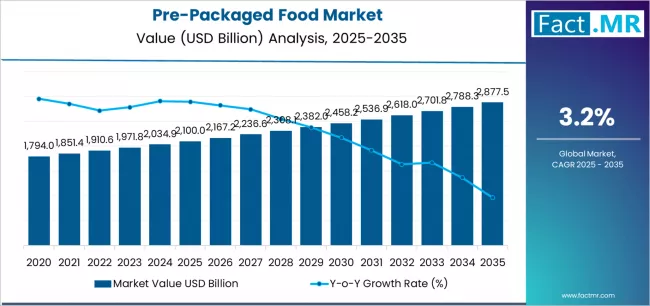
Between 2025 and 2030, the pre-packaged food market is projected to expand from USD 2,100 billion to USD 2,440.0 billion, resulting in a value increase of USD 340.0 billion, which represents 42.5% of the total forecast growth for the decade. This phase of development will be shaped by increasing health consciousness among consumers, rising demand for organic and clean-label products, and growing adoption of e-commerce platforms for food shopping. Food manufacturers and retailers are expanding their pre-packaged food capabilities to address the growing demand for convenient and nutritious meal solutions.
Pre-Packaged Food Market Key Takeaways
| Metric | Value |
|---|---|
| Estimated Value in (2025E) | USD 2,100 billion |
| Forecast Value in (2035F) | USD 2,877.5 billion |
| Forecast CAGR (2025 to 2035) | 3.2% |
From 2030 to 2035, the market is forecast to grow from USD 2,440.0 billion to USD 2,877.5 billion, adding another USD 460.0 billion, which constitutes 57.5% of the overall ten-year expansion. This period is expected to be characterized by the expansion of plant-based and alternative protein products, development of sustainable packaging solutions, and growth of personalized nutrition offerings. The growing adoption of digital technologies and AI-driven food recommendations will drive demand for innovative pre-packaged food products with enhanced nutritional profiles and sustainable credentials.
Between 2020 and 2025, the pre-packaged food market experienced steady growth, driven by the COVID-19 pandemic impact on consumer behavior and growing recognition of pre-packaged foods as essential items for food security and convenience. The market developed as consumers and retailers recognized the potential for pre-packaged food technology to enhance shelf life, improve food safety, and support busy lifestyles while meeting evolving dietary preferences and health requirements.
Why is the Pre-Packaged Food Market Growing?
Market expansion is being supported by the increasing global demand for convenient and ready-to-eat food solutions driven by urbanization trends and busy lifestyles, alongside the corresponding need for extended shelf life products that can maintain nutritional value, ensure food safety, and provide consistent quality across various retail channels and consumer applications. Modern food manufacturers and retailers are increasingly focused on implementing pre-packaged food solutions that can improve supply chain efficiency, reduce food waste, and provide convenient meal options for time-conscious consumers.
The growing emphasis on health and wellness is driving demand for pre-packaged foods that can support clean eating habits, provide transparent ingredient lists, and ensure comprehensive nutritional benefits. Food manufacturers' preference for products that combine convenience with health benefits and sustainability credentials is creating opportunities for innovative pre-packaged food implementations. The rising influence of e-commerce adoption and digital grocery shopping is also contributing to increased adoption of pre-packaged foods that can provide superior shipping characteristics without compromising quality or freshness.
Segmental Analysis
The market is segmented by product type, distribution channel, and claim type. By product type, the market is divided into dairy & bakery, ready meals, and snacks & confectionery. Based on distribution channel, the market is categorized into modern retail, e-commerce, and traditional trade. By claim type, the market is segmented into clean label, functional/fortified, and conventional products.
By Product Type, the Dairy & Bakery Segment Leads the Market
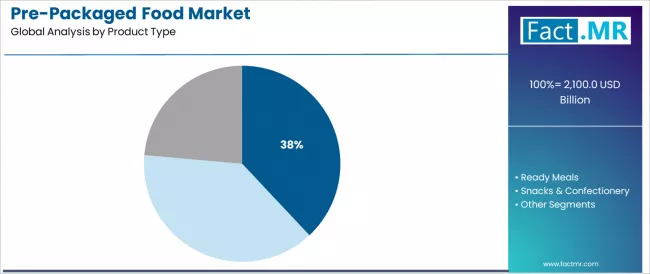
The dairy & bakery segment is projected to maintain its leading position in the pre-packaged food market in 2025 with a 38% market share, reaffirming its role as the preferred product category for everyday consumption and meal solutions. Food manufacturers and retailers increasingly utilize dairy & bakery products for their broad consumer appeal, essential nutritional benefits, and proven effectiveness in meeting diverse dietary preferences while maintaining freshness and quality. This product segment's proven effectiveness and versatility directly address consumer requirements for convenient breakfast options, snacking solutions, and meal accompaniments across various demographic segments and consumption occasions.
This product segment forms the foundation of modern food retail, as it represents the category with the greatest contribution to regular consumption patterns and established market presence across multiple retail formats and consumer segments. Food industry investments in dairy & bakery innovations continue to strengthen adoption among manufacturers and retailers. With consumer preferences requiring convenient and nutritious options, dairy & bakery products align with both convenience objectives and nutritional requirements, making them the central component of comprehensive food retail strategies.
By Distribution Channel, the Modern Retail Segment Dominates Market Demand
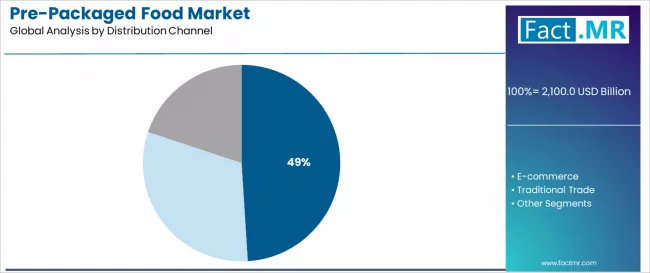
The modern retail distribution channel is projected to represent the largest share of pre-packaged food demand in 2025 with a 49.0% market share, underscoring its critical role as the primary driver for pre-packaged food sales across supermarkets, hypermarkets, and convenience stores. Retailers prefer modern retail channels for pre-packaged foods due to their superior inventory management capabilities, consistent product availability, and ability to provide comprehensive product assortments while supporting brand visibility and promotional activities. Positioned as essential channels for food distribution, modern retail offers both operational advantages and consumer accessibility benefits.
The segment is supported by continuous innovation in retail technology and the growing availability of advanced merchandising solutions that enable superior product presentation with enhanced consumer experience and operational efficiency. Additionally, retailers are investing in comprehensive cold chain infrastructure to support increasingly diverse pre-packaged food offerings and consumer demand for fresh and frozen convenience foods. As consumer shopping patterns evolve and retail technology advances, the modern retail channel will continue to dominate the market while supporting advanced merchandising strategies and consumer convenience optimization.
What are the Drivers, Restraints, and Key Trends of the Pre-Packaged Food Market?
The pre-packaged food market is advancing steadily due to increasing consumer demand for convenience and time-saving meal solutions driven by urbanization and busy lifestyles, alongside growing adoption of health-conscious eating patterns that require nutritional transparency, portion control, and diverse dietary options across various consumer segments and meal occasions. However, the market faces challenges, including rising raw material costs and supply chain disruptions, increasing competition from fresh food alternatives and meal kit services, and regulatory pressures related to packaging sustainability and nutritional labeling requirements. Innovation in sustainable packaging technologies and clean ingredient formulations continues to influence product development and market expansion patterns.
Expansion of Health and Wellness Trends
The growing focus on health and wellness is driving demand for pre-packaged foods that address specific nutritional requirements including protein enrichment, reduced sugar content, enhanced vitamin and mineral profiles, and functional ingredients that support immune health and overall well-being. Health-conscious consumers require advanced pre-packaged food formulations that deliver superior nutritional benefits across multiple health parameters while maintaining convenience and taste appeal. Food manufacturers are increasingly recognizing the competitive advantages of health-focused product development for consumer retention and market differentiation, creating opportunities for innovative formulations specifically designed for health-conscious consumer segments.
Integration of Sustainable Packaging Solutions
Modern pre-packaged food manufacturers are incorporating sustainable packaging technologies and eco-friendly materials to enhance environmental performance, reduce carbon footprint, and support comprehensive sustainability objectives through optimized packaging design and recyclable material utilization. Leading companies are developing biodegradable packaging from plant-based materials, implementing circular packaging strategies, and advancing packaging technologies that minimize environmental impact while maintaining product protection and shelf life. These technologies improve environmental credentials while enabling new market opportunities, including premium sustainable products, environmentally conscious consumer segments, and retailer sustainability partnerships.
Development of Personalized Nutrition Products
The expansion of personalized nutrition trends and data-driven dietary recommendations is driving demand for customized pre-packaged food products with precisely tailored nutritional profiles and ingredient combinations that address individual health goals and dietary restrictions. These advanced applications require specialized product formulations with flexible manufacturing capabilities that exceed traditional mass-market requirements, creating premium market segments with differentiated value propositions. Manufacturers are investing in advanced production capabilities and data analytics systems to serve emerging personalized nutrition applications while supporting innovation in health technology and consumer wellness industries.
Analysis of the Pre-Packaged Food Market by Key Countries
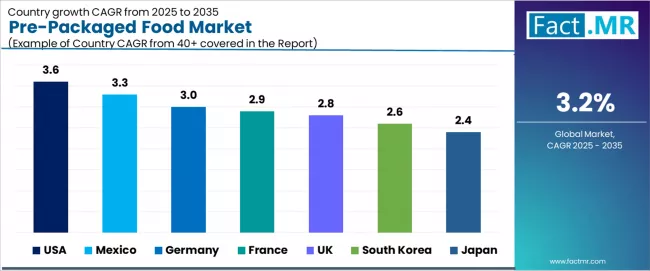
| Country | CAGR (2025-2035) |
|---|---|
| USA | 3.6% |
| Mexico | 3.3% |
| Germany | 3.0% |
| France | 2.9% |
| UK | 2.8% |
| South Korea | 2.6% |
| Japan | 2.4% |
The pre-packaged food market is experiencing steady growth globally, with the USA leading at a 3.6% CAGR through 2035, driven by strong consumer preference for convenience foods, advanced retail infrastructure, and growing health consciousness among consumers. Mexico follows at 3.3%, supported by expanding urban population, rising disposable incomes, and growing adoption of modern retail formats. Germany shows growth at 3.0%, emphasizing premium product segments, organic foods, and sustainable packaging solutions. France demonstrates 2.9% growth, supported by strong food culture, premium product development, and innovative ready meal solutions. The UK records 2.8%, focusing on health-conscious products, plant-based alternatives, and convenient meal solutions. South Korea exhibits 2.6% growth, emphasizing premium snacking products and functional foods. Japan shows 2.4% growth, supported by aging population needs and premium convenience foods.
USA Leads Global Market Growth with Consumer Convenience Focus
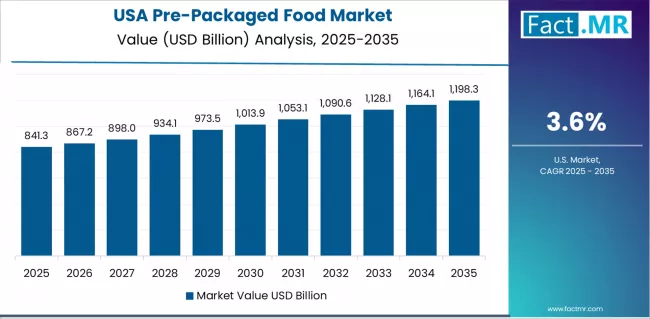
Revenue from pre-packaged food in the USA is projected to exhibit strong growth with a CAGR of 3.6% through 2035, driven by established consumer preference for convenience foods and rapidly growing health-conscious eating patterns supported by advanced retail infrastructure and diverse product offerings. The country's mature retail landscape and increasing investment in innovative food technologies are creating substantial demand for pre-packaged food solutions. Major food manufacturers and retailers are establishing comprehensive product development capabilities to serve both domestic markets and export opportunities.
Government support for food innovation and nutrition labeling transparency is driving demand for pre-packaged foods throughout major metropolitan areas and suburban markets across supermarket chains, convenience stores, and e-commerce platforms.
- Strong consumer preference for convenience and time-saving solutions is supporting the rapid adoption of ready meal technologies among busy professionals and families seeking nutritious and convenient meal options.
Mexico Demonstrates Strong Market Potential with Urban Growth
Revenue from pre-packaged food in Mexico is expanding at a CAGR of 3.3%, supported by the country's rapidly growing urban population, expanding middle class, and increasing adoption of modern retail formats including supermarkets and convenience stores. The country's evolving consumer preferences and retail infrastructure development are driving sophisticated pre-packaged food demand throughout diverse market segments. Leading food manufacturers and international companies are establishing extensive production and distribution facilities to address growing domestic demand.
- Rising disposable incomes and changing lifestyle patterns are creating opportunities for pre-packaged food adoption across ready meals, snacking products, and convenience foods in major urban centers and emerging retail markets.
- Growing modern retail expansion and supply chain development is driving adoption of diverse pre-packaged food categories among retailers seeking enhanced product offerings and inventory management efficiency.
Japan Shows Premium Market Focus with Aging Population Needs
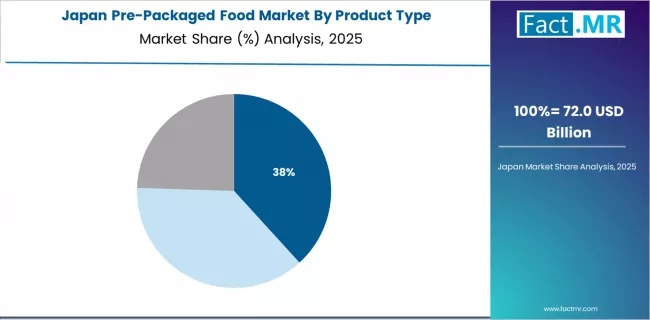
Revenue from pre-packaged food in Japan is expanding at a CAGR of 2.4%, supported by the country's aging population requirements, advanced food technology capabilities, and strong emphasis on quality and convenience in food products. Japan's sophisticated consumer base and technological excellence are driving demand for premium pre-packaged food products. Leading food manufacturers are investing in specialized capabilities for high-quality convenience foods and functional food applications.
- Advanced food processing technology and quality standards are creating opportunities for premium pre-packaged foods throughout urban markets and convenience store networks serving busy professionals and elderly consumers.
- Strong emphasis on health and nutrition is driving adoption of functional pre-packaged foods meeting specific dietary requirements and health objectives across diverse consumer segments.
Germany Demonstrates Engineering Excellence with Premium Applications
Revenue from pre-packaged food in Germany is expanding at a CAGR of 3.0%, driven by the country's strong consumer preference for premium and organic products, advanced retail infrastructure, and comprehensive food safety standards supporting high-quality pre-packaged food development. Germany's retail excellence and consumer sophistication are driving demand for innovative pre-packaged food solutions. Leading food manufacturers and retailers are establishing comprehensive product development programs for next-generation convenience foods.
- Advanced food processing standards and premium consumer requirements are creating demand for specialized pre-packaged foods among health-conscious consumers seeking enhanced nutritional value and sustainability credentials.
- Strong organic food market and environmental consciousness are supporting the adoption of sustainable packaging and clean label products across major retail chains and specialty food stores.
France Focuses on Culinary Innovation and Premium Quality
Revenue from pre-packaged food in France is expanding at a CAGR of 2.9%, driven by the country's strong culinary heritage, premium food culture, and innovative ready meal development incorporating traditional French cuisine elements. France's gastronomic excellence and quality focus are supporting investment in premium pre-packaged food technologies. Major food manufacturers are establishing comprehensive innovation programs incorporating French culinary traditions with modern convenience.
- Advanced culinary expertise and consumer preference for quality are creating demand for premium ready meals and gourmet convenience foods throughout urban markets and specialty retail channels.
- Strong food culture and innovation leadership are driving the adoption of artisanal and chef-crafted pre-packaged foods meeting high culinary standards and authentic taste profiles.
UK Shows Market Maturity with Health-Conscious Trends
Revenue from pre-packaged food in the UK is expanding at a CAGR of 2.8%, supported by the country's mature retail market, strong health consciousness trends, and growing demand for plant-based and functional food products. The UK's established convenience food culture and retail sophistication are driving demand for innovative pre-packaged food solutions. Leading retailers and food companies are investing in health-focused product development and sustainable packaging initiatives.
- Advanced retail infrastructure and consumer health awareness are creating opportunities for functional and better-for-you pre-packaged foods throughout supermarket chains and convenience stores.
- Strong sustainability focus and environmental regulations are driving the adoption of eco-friendly packaging and clean label products across diverse consumer segments.
South Korea Demonstrates Innovation Leadership with Premium Products
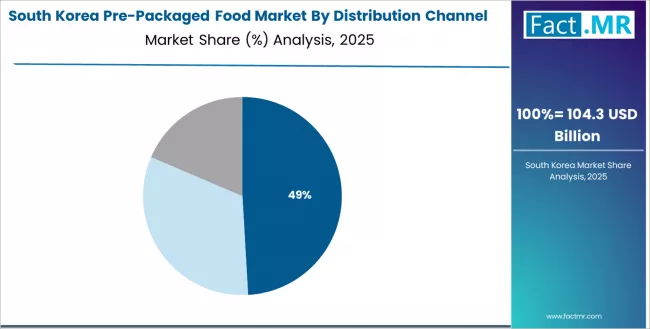
Revenue from pre-packaged food in South Korea is expanding at a CAGR of 2.6%, supported by the country's dynamic food culture, growing export focus, and strong emphasis on premium and innovative food products including K-food trends and health-focused formulations. The nation's advanced food technology infrastructure and consumer sophistication are driving demand for premium pre-packaged food solutions. Leading food companies are investing extensively in product innovation and export market development.
- Advanced food technology capabilities and consumer preference for premium products are creating demand for innovative pre-packaged foods among urban consumers seeking convenience without compromising quality.
- Strong export focus and Korean Wave influence are supporting the adoption of premium Korean food products in both domestic and international markets.
Europe Market Split by Country

The pre-packaged food market in Europe is projected to grow from USD 520.0 billion in 2025 to USD 700.0 billion by 2035, registering a CAGR of 3.0% over the forecast period. Germany is expected to maintain leadership with a 24.5% market share in 2025, moderating to 24.2% by 2035, supported by strong consumer preference for premium and organic products, advanced retail infrastructure, and innovative food technology development.
France follows with 19.2% in 2025, projected to reach 19.4% by 2035, driven by strong culinary culture, premium ready meal development, and growing health-conscious consumer trends. The United Kingdom holds 17.8% in 2025, expected to reach 17.6% by 2035 due to mature market conditions and Brexit-related supply chain adjustments. Italy commands 14.0% in 2025, rising to 14.1% by 2035, while Spain accounts for 10.5% in 2025, reaching 10.6% by 2035. The Rest of Europe region is anticipated to hold 14.0% in 2025 and 14.1% by 2035, reflecting steady growth in Nordic countries and emerging Eastern European markets implementing modern retail expansion programs.
Competitive Landscape of the Pre-Packaged Food Market

The pre-packaged food market is characterized by competition among established multinational food companies, regional food processors, and emerging health-focused brands. Companies are investing in sustainable packaging technology development, clean label innovation, product portfolio diversification, and health-conscious formulation development to deliver convenient, nutritious, and environmentally responsible pre-packaged food solutions. Innovation in plant-based alternatives, functional ingredients, and personalized nutrition technologies is central to strengthening market position and competitive advantage.
Nestlé leads the market with a 4.2% share, offering comprehensive pre-packaged food solutions with focus on health and wellness, sustainable packaging, and global brand portfolio across diverse consumer segments and market channels. The company continues expanding its plant-based product range and sustainable packaging initiatives while investing in digital consumer engagement and personalized nutrition platforms. PepsiCo provides innovative snacking and beverage solutions with emphasis on better-for-you products and sustainability commitments. Mondelez specializes in premium snacking categories with global reach and brand strength. Unilever offers comprehensive food solutions with sustainability leadership and health-focused innovation. Kraft Heinz focuses on iconic brands and operational excellence. General Mills emphasizes organic and natural products with strong breakfast and snacking portfolios.
Key Players in the Pre-Packaged Food Market
- Nestlé
- PepsiCo
- Mondelez
- Unilever
- Kraft Heinz
- General Mills
- Danone
- Mars
- Kellogg
- Conagra
Scope of the Report
| Items | Values |
|---|---|
| Quantitative Units (2025) | USD 2,100 billion |
| Product Type | Dairy & Bakery, Ready Meals, Snacks & Confectionery |
| Distribution Channel | Modern Retail, E-commerce, Traditional Trade |
| Claim Type | Clean Label, Functional/Fortified, Conventional |
| Regions Covered | North America, Europe, Asia-Pacific, Latin America, Middle East & Africa |
| Countries Covered | USA, Mexico, Germany, France, UK, Japan, South Korea, and 40+ countries |
| Key Companies Profiled | Nestlé, PepsiCo, Mondelez, Unilever, Kraft Heinz, General Mills |
| Additional Attributes | Dollar sales by product type and distribution channel, regional demand trends, competitive landscape, technological advancements in food processing, sustainability development, clean label innovation, and health-focused formulation optimization |
Pre-Packaged Food Market by Segments
-
Product Type :
- Dairy & Bakery
- Ready Meals
- Snacks & Confectionery
-
Distribution Channel :
- Modern Retail
- E-commerce
- Traditional Trade
-
Claim Type :
- Clean Label
- Functional/Fortified
- Conventional
-
Region :
-
North America
- United States
- Canada
- Mexico
-
Europe
- Germany
- United Kingdom
- France
- Italy
- Spain
- Netherlands
- Rest of Europe
-
Asia-Pacific
- Japan
- South Korea
- China
- India
- Australia
- Rest of Asia-Pacific
-
Latin America
- Brazil
- Argentina
- Rest of Latin America
-
Middle East & Africa
- Kingdom of Saudi Arabia
- South Africa
- Rest of Middle East & Africa
-
Table of Content
- Executive Summary
- Global Market Outlook
- Demand to side Trends
- Supply to side Trends
- Technology Roadmap Analysis
- Analysis and Recommendations
- Market Overview
- Market Coverage / Taxonomy
- Market Definition / Scope / Limitations
- Market Background
- Market Dynamics
- Drivers
- Restraints
- Opportunity
- Trends
- Scenario Forecast
- Demand in Optimistic Scenario
- Demand in Likely Scenario
- Demand in Conservative Scenario
- Opportunity Map Analysis
- Product Life Cycle Analysis
- Supply Chain Analysis
- Investment Feasibility Matrix
- Value Chain Analysis
- PESTLE and Porter’s Analysis
- Regulatory Landscape
- Regional Parent Market Outlook
- Production and Consumption Statistics
- Import and Export Statistics
- Market Dynamics
- Global Market Analysis 2020 to 2024 and Forecast, 2025 to 2035
- Historical Market Size Value (USD Million) Analysis, 2020 to 2024
- Current and Future Market Size Value (USD Million) Projections, 2025 to 2035
- Y to o to Y Growth Trend Analysis
- Absolute $ Opportunity Analysis
- Global Market Pricing Analysis 2020 to 2024 and Forecast 2025 to 2035
- Global Market Analysis 2020 to 2024 and Forecast 2025 to 2035, By Product Type
- Introduction / Key Findings
- Historical Market Size Value (USD Million) Analysis By Product Type , 2020 to 2024
- Current and Future Market Size Value (USD Million) Analysis and Forecast By Product Type , 2025 to 2035
- Dairy & Bakery
- Ready Meals
- Snacks & Confectionery
- Y to o to Y Growth Trend Analysis By Product Type , 2020 to 2024
- Absolute $ Opportunity Analysis By Product Type , 2025 to 2035
- Global Market Analysis 2020 to 2024 and Forecast 2025 to 2035, By Distribution Channel
- Introduction / Key Findings
- Historical Market Size Value (USD Million) Analysis By Distribution Channel, 2020 to 2024
- Current and Future Market Size Value (USD Million) Analysis and Forecast By Distribution Channel, 2025 to 2035
- Modern Retail
- E-commerce
- Traditional Trade
- Y to o to Y Growth Trend Analysis By Distribution Channel, 2020 to 2024
- Absolute $ Opportunity Analysis By Distribution Channel, 2025 to 2035
- Global Market Analysis 2020 to 2024 and Forecast 2025 to 2035, By Region
- Introduction
- Historical Market Size Value (USD Million) Analysis By Region, 2020 to 2024
- Current Market Size Value (USD Million) Analysis and Forecast By Region, 2025 to 2035
- North America
- Latin America
- Western Europe
- Eastern Europe
- East Asia
- South Asia and Pacific
- Middle East & Africa
- Market Attractiveness Analysis By Region
- North America Market Analysis 2020 to 2024 and Forecast 2025 to 2035, By Country
- Historical Market Size Value (USD Million) Trend Analysis By Market Taxonomy, 2020 to 2024
- Market Size Value (USD Million) Forecast By Market Taxonomy, 2025 to 2035
- By Country
- USA
- Canada
- Mexico
- By Product Type
- By Distribution Channel
- By Country
- Market Attractiveness Analysis
- By Country
- By Product Type
- By Distribution Channel
- Key Takeaways
- Latin America Market Analysis 2020 to 2024 and Forecast 2025 to 2035, By Country
- Historical Market Size Value (USD Million) Trend Analysis By Market Taxonomy, 2020 to 2024
- Market Size Value (USD Million) Forecast By Market Taxonomy, 2025 to 2035
- By Country
- Brazil
- Chile
- Rest of Latin America
- By Product Type
- By Distribution Channel
- By Country
- Market Attractiveness Analysis
- By Country
- By Product Type
- By Distribution Channel
- Key Takeaways
- Western Europe Market Analysis 2020 to 2024 and Forecast 2025 to 2035, By Country
- Historical Market Size Value (USD Million) Trend Analysis By Market Taxonomy, 2020 to 2024
- Market Size Value (USD Million) Forecast By Market Taxonomy, 2025 to 2035
- By Country
- Germany
- UK
- Italy
- Spain
- France
- Nordic
- BENELUX
- Rest of Western Europe
- By Product Type
- By Distribution Channel
- By Country
- Market Attractiveness Analysis
- By Country
- By Product Type
- By Distribution Channel
- Key Takeaways
- Eastern Europe Market Analysis 2020 to 2024 and Forecast 2025 to 2035, By Country
- Historical Market Size Value (USD Million) Trend Analysis By Market Taxonomy, 2020 to 2024
- Market Size Value (USD Million) Forecast By Market Taxonomy, 2025 to 2035
- By Country
- Russia
- Poland
- Hungary
- Balkan & Baltic
- Rest of Eastern Europe
- By Product Type
- By Distribution Channel
- By Country
- Market Attractiveness Analysis
- By Country
- By Product Type
- By Distribution Channel
- Key Takeaways
- East Asia Market Analysis 2020 to 2024 and Forecast 2025 to 2035, By Country
- Historical Market Size Value (USD Million) Trend Analysis By Market Taxonomy, 2020 to 2024
- Market Size Value (USD Million) Forecast By Market Taxonomy, 2025 to 2035
- By Country
- China
- Japan
- South Korea
- By Product Type
- By Distribution Channel
- By Country
- Market Attractiveness Analysis
- By Country
- By Product Type
- By Distribution Channel
- Key Takeaways
- South Asia and Pacific Market Analysis 2020 to 2024 and Forecast 2025 to 2035, By Country
- Historical Market Size Value (USD Million) Trend Analysis By Market Taxonomy, 2020 to 2024
- Market Size Value (USD Million) Forecast By Market Taxonomy, 2025 to 2035
- By Country
- India
- ASEAN
- Australia & New Zealand
- Rest of South Asia and Pacific
- By Product Type
- By Distribution Channel
- By Country
- Market Attractiveness Analysis
- By Country
- By Product Type
- By Distribution Channel
- Key Takeaways
- Middle East & Africa Market Analysis 2020 to 2024 and Forecast 2025 to 2035, By Country
- Historical Market Size Value (USD Million) Trend Analysis By Market Taxonomy, 2020 to 2024
- Market Size Value (USD Million) Forecast By Market Taxonomy, 2025 to 2035
- By Country
- Kingdom of Saudi Arabia
- Other GCC Countries
- Turkiye
- South Africa
- Other African Union
- Rest of Middle East & Africa
- By Product Type
- By Distribution Channel
- By Country
- Market Attractiveness Analysis
- By Country
- By Product Type
- By Distribution Channel
- Key Takeaways
- Key Countries Market Analysis
- USA
- Pricing Analysis
- Market Share Analysis, 2024
- By Product Type
- By Distribution Channel
- Canada
- Pricing Analysis
- Market Share Analysis, 2024
- By Product Type
- By Distribution Channel
- Mexico
- Pricing Analysis
- Market Share Analysis, 2024
- By Product Type
- By Distribution Channel
- Brazil
- Pricing Analysis
- Market Share Analysis, 2024
- By Product Type
- By Distribution Channel
- Chile
- Pricing Analysis
- Market Share Analysis, 2024
- By Product Type
- By Distribution Channel
- Germany
- Pricing Analysis
- Market Share Analysis, 2024
- By Product Type
- By Distribution Channel
- UK
- Pricing Analysis
- Market Share Analysis, 2024
- By Product Type
- By Distribution Channel
- Italy
- Pricing Analysis
- Market Share Analysis, 2024
- By Product Type
- By Distribution Channel
- Spain
- Pricing Analysis
- Market Share Analysis, 2024
- By Product Type
- By Distribution Channel
- France
- Pricing Analysis
- Market Share Analysis, 2024
- By Product Type
- By Distribution Channel
- India
- Pricing Analysis
- Market Share Analysis, 2024
- By Product Type
- By Distribution Channel
- ASEAN
- Pricing Analysis
- Market Share Analysis, 2024
- By Product Type
- By Distribution Channel
- Australia & New Zealand
- Pricing Analysis
- Market Share Analysis, 2024
- By Product Type
- By Distribution Channel
- China
- Pricing Analysis
- Market Share Analysis, 2024
- By Product Type
- By Distribution Channel
- Japan
- Pricing Analysis
- Market Share Analysis, 2024
- By Product Type
- By Distribution Channel
- South Korea
- Pricing Analysis
- Market Share Analysis, 2024
- By Product Type
- By Distribution Channel
- Russia
- Pricing Analysis
- Market Share Analysis, 2024
- By Product Type
- By Distribution Channel
- Poland
- Pricing Analysis
- Market Share Analysis, 2024
- By Product Type
- By Distribution Channel
- Hungary
- Pricing Analysis
- Market Share Analysis, 2024
- By Product Type
- By Distribution Channel
- Kingdom of Saudi Arabia
- Pricing Analysis
- Market Share Analysis, 2024
- By Product Type
- By Distribution Channel
- Turkiye
- Pricing Analysis
- Market Share Analysis, 2024
- By Product Type
- By Distribution Channel
- South Africa
- Pricing Analysis
- Market Share Analysis, 2024
- By Product Type
- By Distribution Channel
- USA
- Market Structure Analysis
- Competition Dashboard
- Competition Benchmarking
- Market Share Analysis of Top Players
- By Regional
- By Product Type
- By Distribution Channel
- Competition Analysis
- Competition Deep Dive
- Nestlé
- Overview
- Product Portfolio
- Profitability by Market Segments (Product/Age /Sales Channel/Region)
- Sales Footprint
- Strategy Overview
- Marketing Strategy
- Product Strategy
- Channel Strategy
- PepsiCo
- Mondelez
- Unilever
- Kraft Heinz
- General Mills
- Danone
- Mars
- Kellogg
- Conagra
- Nestlé
- Competition Deep Dive
- Assumptions & Acronyms Used
- Research Methodology
List Of Table
- Table 1: Global Market Value (USD Million) Forecast by Region, 2020 to 2035
- Table 2: Global Market Value (USD Million) Forecast by Product Type , 2020 to 2035
- Table 3: Global Market Value (USD Million) Forecast by Distribution Channel, 2020 to 2035
- Table 4: North America Market Value (USD Million) Forecast by Country, 2020 to 2035
- Table 5: North America Market Value (USD Million) Forecast by Product Type , 2020 to 2035
- Table 6: North America Market Value (USD Million) Forecast by Distribution Channel, 2020 to 2035
- Table 7: Latin America Market Value (USD Million) Forecast by Country, 2020 to 2035
- Table 8: Latin America Market Value (USD Million) Forecast by Product Type , 2020 to 2035
- Table 9: Latin America Market Value (USD Million) Forecast by Distribution Channel, 2020 to 2035
- Table 10: Western Europe Market Value (USD Million) Forecast by Country, 2020 to 2035
- Table 11: Western Europe Market Value (USD Million) Forecast by Product Type , 2020 to 2035
- Table 12: Western Europe Market Value (USD Million) Forecast by Distribution Channel, 2020 to 2035
- Table 13: Eastern Europe Market Value (USD Million) Forecast by Country, 2020 to 2035
- Table 14: Eastern Europe Market Value (USD Million) Forecast by Product Type , 2020 to 2035
- Table 15: Eastern Europe Market Value (USD Million) Forecast by Distribution Channel, 2020 to 2035
- Table 16: East Asia Market Value (USD Million) Forecast by Country, 2020 to 2035
- Table 17: East Asia Market Value (USD Million) Forecast by Product Type , 2020 to 2035
- Table 18: East Asia Market Value (USD Million) Forecast by Distribution Channel, 2020 to 2035
- Table 19: South Asia and Pacific Market Value (USD Million) Forecast by Country, 2020 to 2035
- Table 20: South Asia and Pacific Market Value (USD Million) Forecast by Product Type , 2020 to 2035
- Table 21: South Asia and Pacific Market Value (USD Million) Forecast by Distribution Channel, 2020 to 2035
- Table 22: Middle East & Africa Market Value (USD Million) Forecast by Country, 2020 to 2035
- Table 23: Middle East & Africa Market Value (USD Million) Forecast by Product Type , 2020 to 2035
- Table 24: Middle East & Africa Market Value (USD Million) Forecast by Distribution Channel, 2020 to 2035
List Of Figures
- Figure 1: Global Market Pricing Analysis
- Figure 2: Global Market Value (USD Million) Forecast 2020-2035
- Figure 3: Global Market Value Share and BPS Analysis by Product Type , 2025 and 2035
- Figure 4: Global Market Y to o to Y Growth Comparison by Product Type , 2025-2035
- Figure 5: Global Market Attractiveness Analysis by Product Type
- Figure 6: Global Market Value Share and BPS Analysis by Distribution Channel, 2025 and 2035
- Figure 7: Global Market Y to o to Y Growth Comparison by Distribution Channel, 2025-2035
- Figure 8: Global Market Attractiveness Analysis by Distribution Channel
- Figure 9: Global Market Value (USD Million) Share and BPS Analysis by Region, 2025 and 2035
- Figure 10: Global Market Y to o to Y Growth Comparison by Region, 2025-2035
- Figure 11: Global Market Attractiveness Analysis by Region
- Figure 12: North America Market Incremental Dollar Opportunity, 2025-2035
- Figure 13: Latin America Market Incremental Dollar Opportunity, 2025-2035
- Figure 14: Western Europe Market Incremental Dollar Opportunity, 2025-2035
- Figure 15: Eastern Europe Market Incremental Dollar Opportunity, 2025-2035
- Figure 16: East Asia Market Incremental Dollar Opportunity, 2025-2035
- Figure 17: South Asia and Pacific Market Incremental Dollar Opportunity, 2025-2035
- Figure 18: Middle East & Africa Market Incremental Dollar Opportunity, 2025-2035
- Figure 19: North America Market Value Share and BPS Analysis by Country, 2025 and 2035
- Figure 20: North America Market Value Share and BPS Analysis by Product Type , 2025 and 2035
- Figure 21: North America Market Y to o to Y Growth Comparison by Product Type , 2025-2035
- Figure 22: North America Market Attractiveness Analysis by Product Type
- Figure 23: North America Market Value Share and BPS Analysis by Distribution Channel, 2025 and 2035
- Figure 24: North America Market Y to o to Y Growth Comparison by Distribution Channel, 2025-2035
- Figure 25: North America Market Attractiveness Analysis by Distribution Channel
- Figure 26: Latin America Market Value Share and BPS Analysis by Country, 2025 and 2035
- Figure 27: Latin America Market Value Share and BPS Analysis by Product Type , 2025 and 2035
- Figure 28: Latin America Market Y to o to Y Growth Comparison by Product Type , 2025-2035
- Figure 29: Latin America Market Attractiveness Analysis by Product Type
- Figure 30: Latin America Market Value Share and BPS Analysis by Distribution Channel, 2025 and 2035
- Figure 31: Latin America Market Y to o to Y Growth Comparison by Distribution Channel, 2025-2035
- Figure 32: Latin America Market Attractiveness Analysis by Distribution Channel
- Figure 33: Western Europe Market Value Share and BPS Analysis by Country, 2025 and 2035
- Figure 34: Western Europe Market Value Share and BPS Analysis by Product Type , 2025 and 2035
- Figure 35: Western Europe Market Y to o to Y Growth Comparison by Product Type , 2025-2035
- Figure 36: Western Europe Market Attractiveness Analysis by Product Type
- Figure 37: Western Europe Market Value Share and BPS Analysis by Distribution Channel, 2025 and 2035
- Figure 38: Western Europe Market Y to o to Y Growth Comparison by Distribution Channel, 2025-2035
- Figure 39: Western Europe Market Attractiveness Analysis by Distribution Channel
- Figure 40: Eastern Europe Market Value Share and BPS Analysis by Country, 2025 and 2035
- Figure 41: Eastern Europe Market Value Share and BPS Analysis by Product Type , 2025 and 2035
- Figure 42: Eastern Europe Market Y to o to Y Growth Comparison by Product Type , 2025-2035
- Figure 43: Eastern Europe Market Attractiveness Analysis by Product Type
- Figure 44: Eastern Europe Market Value Share and BPS Analysis by Distribution Channel, 2025 and 2035
- Figure 45: Eastern Europe Market Y to o to Y Growth Comparison by Distribution Channel, 2025-2035
- Figure 46: Eastern Europe Market Attractiveness Analysis by Distribution Channel
- Figure 47: East Asia Market Value Share and BPS Analysis by Country, 2025 and 2035
- Figure 48: East Asia Market Value Share and BPS Analysis by Product Type , 2025 and 2035
- Figure 49: East Asia Market Y to o to Y Growth Comparison by Product Type , 2025-2035
- Figure 50: East Asia Market Attractiveness Analysis by Product Type
- Figure 51: East Asia Market Value Share and BPS Analysis by Distribution Channel, 2025 and 2035
- Figure 52: East Asia Market Y to o to Y Growth Comparison by Distribution Channel, 2025-2035
- Figure 53: East Asia Market Attractiveness Analysis by Distribution Channel
- Figure 54: South Asia and Pacific Market Value Share and BPS Analysis by Country, 2025 and 2035
- Figure 55: South Asia and Pacific Market Value Share and BPS Analysis by Product Type , 2025 and 2035
- Figure 56: South Asia and Pacific Market Y to o to Y Growth Comparison by Product Type , 2025-2035
- Figure 57: South Asia and Pacific Market Attractiveness Analysis by Product Type
- Figure 58: South Asia and Pacific Market Value Share and BPS Analysis by Distribution Channel, 2025 and 2035
- Figure 59: South Asia and Pacific Market Y to o to Y Growth Comparison by Distribution Channel, 2025-2035
- Figure 60: South Asia and Pacific Market Attractiveness Analysis by Distribution Channel
- Figure 61: Middle East & Africa Market Value Share and BPS Analysis by Country, 2025 and 2035
- Figure 62: Middle East & Africa Market Value Share and BPS Analysis by Product Type , 2025 and 2035
- Figure 63: Middle East & Africa Market Y to o to Y Growth Comparison by Product Type , 2025-2035
- Figure 64: Middle East & Africa Market Attractiveness Analysis by Product Type
- Figure 65: Middle East & Africa Market Value Share and BPS Analysis by Distribution Channel, 2025 and 2035
- Figure 66: Middle East & Africa Market Y to o to Y Growth Comparison by Distribution Channel, 2025-2035
- Figure 67: Middle East & Africa Market Attractiveness Analysis by Distribution Channel
- Figure 68: Global Market - Tier Structure Analysis
- Figure 69: Global Market - Company Share Analysis
- FAQs -
How big is the pre-packaged food market in 2025?
The global pre-packaged food market is estimated to be valued at USD 2,100.0 billion in 2025.
What will be the size of pre-packaged food market in 2035?
The market size for the pre-packaged food market is projected to reach USD 2,877.5 billion by 2035.
How much will be the pre-packaged food market growth between 2025 and 2035?
The pre-packaged food market is expected to grow at a 3.2% CAGR between 2025 and 2035.
What are the key product types in the pre-packaged food market?
The key product types in pre-packaged food market are dairy & bakery, ready meals and snacks & confectionery.
Which distribution channel segment to contribute significant share in the pre-packaged food market in 2025?
In terms of distribution channel, modern retail segment to command 49.0% share in the pre-packaged food market in 2025.